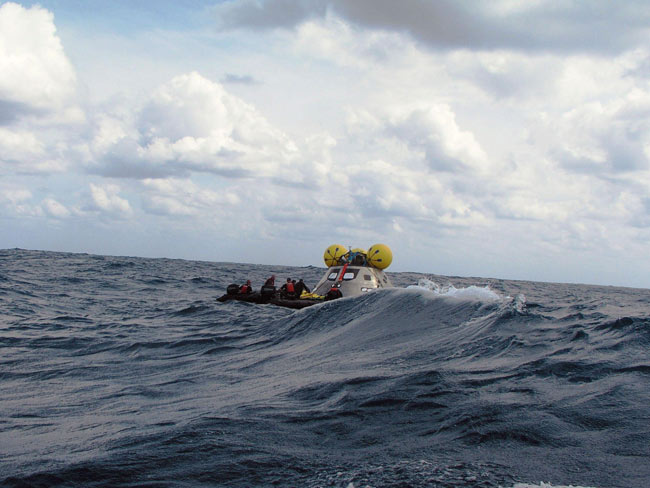NASA's New Spaceship to Carry Fewer Astronauts

NASA has cutthe crew size for its new Orion spacecraft down from six seats to four in orderto keep the space shuttle replacement on track for a March 2015 debut.
The spaceagency made the decision earlier this month in order to meet its commitment tobegin operational manned flights on the Orion CrewExploration Vehicle - NASA?s successor for its retiring space shuttles - by2015. Before the crew reduction, the agency was preparing two parallel Orion designs:a six-person version to ferry crews to the International Space Station, and afour-seater to send astronauts backto the moon by 2020.
?We?re notgiving up on the six-crew capability of Orion,? said Jeff Hanley, NASA?sprogram manager for the Constellation project that includes Orion and its Aresrockets, on Wednesday. ?We will need it someday. We don?t need it early.?
NASA?sOrion spacecraft are capsule-based vehicles designed to replace the spaceagency?s three aging space shuttles: Discovery, Atlantis and Endeavour. Theorbiters are due to retire at the end of 2010, though Congressional lawmakershave drawnup a budget resolution that could delay mothballing the fleet until atleast 2011 if approved.
Hanley saidthe decision to reduce Orion?s crew size for the near-term stemmed from arecent report on ways NASA could accelerate its Constellation program effortsto build the new spaceship, retire the space shuttles and begin operationalflights with the new craft in 2015. Cutting the crew size eliminates the extratime and funding needed to design, build and certify two different Orionvehicles - the four-seater and six-seater - at the same time.
?We feltthat that was a good program management option to go exercise to simplify thedesign a little bit,? Hanley told reporters in a teleconference today.
Bridgingthe shuttle gap
Get the Space.com Newsletter
Breaking space news, the latest updates on rocket launches, skywatching events and more!
NASA alreadyexpects a gap of up to five years between the shuttle fleet?s retirement andthe first operational flight of Orion. During that time, NASA would have torely on Russia?s Soyuz spacecraft to launch astronauts to the station, as wellas cargo ships built by Russia, Europe and Japan. The agency is also hoping touse American-built commercial spacecraft, such as the Dragon vehicle and arocket under development by Space Exploration Technologies, to carry U.S. cargoto the station. Those privately built spacecraft, however, have yet to fly.
Last week,a Congressional Budget Office report questioned NASA?s ability to meet its March2015 target for operational Orion flights without an infusionof billions of dollars in extra funding. But Hanley disagreed, saying Wednesdaythat there is sufficient funding and congressional support for NASA?s plans, but only if the agency drawsup a streamlined schedule for testing.
Hanley saidhis team is considering canceling a second test flight of the Ares I rocketthat will launch Orion capsules into space. The firsttest, Ares I-X, is slated to launch no earlier than late August.Engineers are now studying whether the effort to launch a second planned flight? Ares I-Y ? is worth the money and manpower required, or if it should be foldedinto a full-up Ares I launch or other test.
Morespace for station
Afour-person Orion option will free up some mass and cargo space for moresupplies for station-bound missions, Hanley said. But it also means the spacestation will likely still require a second crew-carrying spacecraft, such as aRussian Soyuz, on hand to provide escape capability for the outpost?s fullsix-person complement. Soyuz spacecraft can ferry three spaceflyers to thespace station and stay parked in orbit for about six months. NASA?s spaceshuttles can carry seven astronauts on missions that average just over twoweeks in duration.
Soyuzvehicles were already expected to be flying to and from the space station at thetime as Orion, NASA officials said.
?The four-seat Orion will still meet all U.S. needs, bothfor [space station] crew exchange and rescue,? NASA spokesperson KatherineTrinidad told SPACE.com. ?No additional Soyuz seats are needed as aresult of the change in crew size.?
The spacestation is expected to begin full six-person operations in late May, when asecond Soyuz vehicle will ferry three new astronauts to the outpost.
?I thinkit?s safe to say that our Russian partners will always want to have their own meansto arrive at space station,? Hanley said. ?Having a diversity in access to the InternationalSpace Station is actually a good thing.?
- Video - NASA's Constellation Journey Begins: Part 1, Part 2
- End in Sight: Final Space Shuttle Missions Slated
- Image Gallery - The First 100 Space Shuttle Flights
Join our Space Forums to keep talking space on the latest missions, night sky and more! And if you have a news tip, correction or comment, let us know at: community@space.com.

Tariq is the Editor-in-Chief of Space.com and joined the team in 2001, first as an intern and staff writer, and later as an editor. He covers human spaceflight, exploration and space science, as well as skywatching and entertainment. He became Space.com's Managing Editor in 2009 and Editor-in-Chief in 2019. Before joining Space.com, Tariq was a staff reporter for The Los Angeles Times covering education and city beats in La Habra, Fullerton and Huntington Beach. In October 2022, Tariq received the Harry Kolcum Award for excellence in space reporting from the National Space Club Florida Committee. He is also an Eagle Scout (yes, he has the Space Exploration merit badge) and went to Space Camp four times as a kid and a fifth time as an adult. He has journalism degrees from the University of Southern California and New York University. You can find Tariq at Space.com and as the co-host to the This Week In Space podcast with space historian Rod Pyle on the TWiT network. To see his latest project, you can follow Tariq on Twitter @tariqjmalik.









